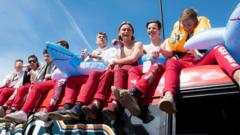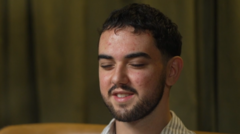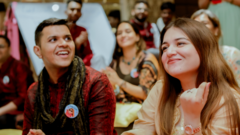Norwegian school-leavers, known as russ, have embraced a vibrant tradition of celebrations leading up to their national day on May 17. This year, however, the phenomenon of the russebuss, or party bus, has sparked considerable concern from parents and local authorities. Many teenagers, like 18-year-old Selma Jenvin-Steinsvag, eagerly partake in this joyful rite of passage, donning colorful overalls as they celebrate completing their written exams. But critics say these celebrations have begun weeks in advance, causing potential disruptions.
Participants claim that the russebuss, which operates through the night, is characterized by loud music and unrestrained partying. As 19-year-old Edvard Aanestad noted, this phenomenon comes at great financial cost, leading some students to incur substantial debt. Alongside joy, these festivities are marred by heavy drinking, drug use, and inadequate sleep, prompting concerns over the negative effects on students' academic performance.
Prime Minister Jonas Gahr Støre acknowledged that while he personally cherished his graduation festivities, the current culture surrounding the russebuss has gone awry. Similarly, parents like Solveig Haukenes Aase argue that the relentless party atmosphere has now begun to influence younger adolescents. Aase has taken initiative with other concerned parents to address the need for a safer environment for youth.
Taking these issues into account, Education Minister Kari Nessa Nordtun confirmed plans to overhaul the celebration system, advocating for post-exam festivities while working to decrease peer pressure and social division—both heightened by the escalating expenses associated with the party buses.
Historically, the russebuss trend began in Oslo during the early 1980s, normally favored by elite schools, but has since become widespread across Norway. Cultural expert Ivar Brandvol cites the significant financial burdens required for participation in bus groups, with some budgets soaring up to 3 million kroner (£220,000). To offset costs, many students take on odd jobs, contributing to an unhealthy financial strain.
As authorities push for stricter regulations, including the banning of unsafe seating arrangements on buses, student sentiment is mixed. Both Edvard and his friend Henrik warn that anticipated governmental measures could further deepen existing feelings of exclusion rather than solve them. Despite the challenges, many students express pride in their rites of passage and question whether new policies genuinely serve inclusivity or simply limit access to these celebrated traditions.
Participants claim that the russebuss, which operates through the night, is characterized by loud music and unrestrained partying. As 19-year-old Edvard Aanestad noted, this phenomenon comes at great financial cost, leading some students to incur substantial debt. Alongside joy, these festivities are marred by heavy drinking, drug use, and inadequate sleep, prompting concerns over the negative effects on students' academic performance.
Prime Minister Jonas Gahr Støre acknowledged that while he personally cherished his graduation festivities, the current culture surrounding the russebuss has gone awry. Similarly, parents like Solveig Haukenes Aase argue that the relentless party atmosphere has now begun to influence younger adolescents. Aase has taken initiative with other concerned parents to address the need for a safer environment for youth.
Taking these issues into account, Education Minister Kari Nessa Nordtun confirmed plans to overhaul the celebration system, advocating for post-exam festivities while working to decrease peer pressure and social division—both heightened by the escalating expenses associated with the party buses.
Historically, the russebuss trend began in Oslo during the early 1980s, normally favored by elite schools, but has since become widespread across Norway. Cultural expert Ivar Brandvol cites the significant financial burdens required for participation in bus groups, with some budgets soaring up to 3 million kroner (£220,000). To offset costs, many students take on odd jobs, contributing to an unhealthy financial strain.
As authorities push for stricter regulations, including the banning of unsafe seating arrangements on buses, student sentiment is mixed. Both Edvard and his friend Henrik warn that anticipated governmental measures could further deepen existing feelings of exclusion rather than solve them. Despite the challenges, many students express pride in their rites of passage and question whether new policies genuinely serve inclusivity or simply limit access to these celebrated traditions.



















